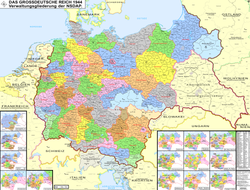Gau Lower Silesia
| Gau Lower Silesia | |||||
| Gau of Nazi Germany | |||||
|
|||||
|
Flag |
|||||
| Capital | Breslau | ||||
| Gauleiter | |||||
| • | 1941–1945 | Karl Hanke | |||
| History | |||||
| • | 27 January 1941 | ||||
| • | Disestablishment | 8 May 1945 | |||
| Today part of |
|
||||
Flag
The Gau Lower Silesia (German: Gau Niederschlesien ) was an administrative division of Nazi Germany from 1941 to 1945 in the Lower Silesia part of the Prussian Province of Silesia. The Gau was created when the Gau Silesia was split into Lower Silesia and Upper Silesia in 1941. The majority of the former Gau became part of Poland after the Second World War, with small parts in the far west becoming part of the future East Germany.
The Nazi Gau (plural Gaue) system was originally established in a party conference on 22 May 1926, in order to improve administration of the party structure. From 1933 onwards, after the Nazi seizure of power, the Gaue increasingly replaced the German states as administrative subdivisions in Germany.
At the head of each Gau stood a Gauleiter, a position which became increasingly more powerful, especially after the outbreak of the Second World War, with little interference from above. Local Gauleiter often held government positions as well as party ones and were in charge of, among other things, propaganda and surveillance and, from September 1944 onward, the Volkssturm and the defense of the Gau.
...
Wikipedia


